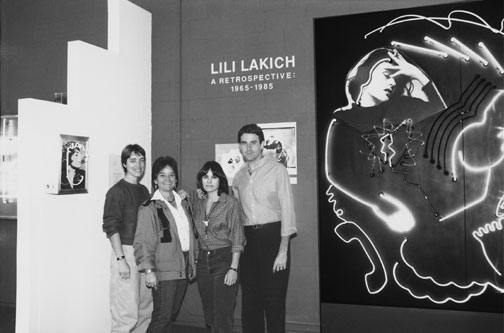

expression
of “rage, rage against the dying of the light” that is mortality.
Lakich’s formal concerns come to the fore in a series of portraits that
she describes as a collection of lines that have been assembled into minimal
codes for the human face. Color and line cohere in the idealized portraits
titled The Sorcerer and Holy Ghost.
Sidewinder is a more symbolic portrait whose simple
lines are used to capture the spiritual ethos of its living subject. Donna
Impaled as a Constellation (1983) is a large-scale spiritual
portrait of Donna Tracy that reflects the cosmological concerns of its subject
by its use of a series of intersecting lines connoting the heavens. Here Lakich
points out similarities between connect-the-dot puzzles, the constellations
and the construction of an image in neon.
A key piece in the exhibit is Elvis
(1985). In it the iconic value of neon is joined to the representation of
a human social icon. The large aluminum and copper cut-out shape is embellished
with relatively simple angular neon lines that blink back and forth to convey
the kinetic energy of rock and roll. Another musician is the subject in The
Ghost of John Coltrane (1985), an atmospheric portrait that
conveys both the spiritual character of its subject and the improvisatory
freedom of jazz.
Over a hundred works in this show, including drawings and
mixed-media constructions, trace the evolution of Lakich’s art from
the relatively simple applications of neon in the 1966 abstractions Purple
Heart and You to the full-blown mastery
of her later works. The Museum of Neon Art was founded by Lakich in 1981 to
exhibit, document and preserve electric and kinetic art forms. But the esthetic
legitimacy of the medium is a given in Lakich’s own work; looking at
her pieces, one moves beyond the medium itself into an expression of the human
condition.
“SPECTRAL PSALMS” by Ray Zone, published in ARTWEEK March 8, 1986
